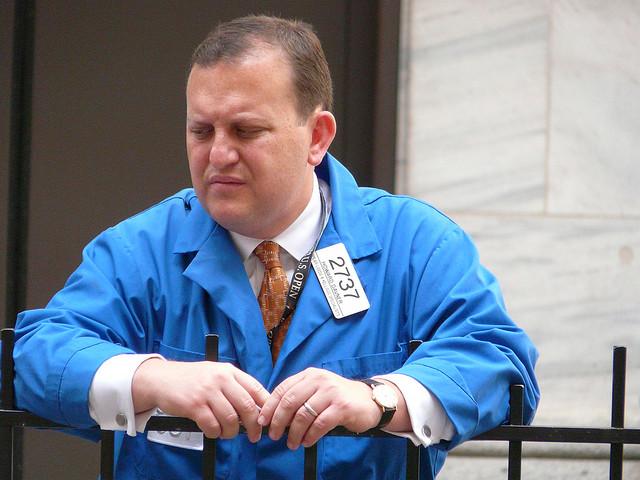Huge Fall in Global Markets Causes Fear and Panic for Investors
September 16, 2008, as a result of the failure of over a dozen large banks in the United States, was the beginning of a stock market crisis around the world. On October 11, 2008, the head of the International Monetary Fund (IMF) warned that the world financial system was teetering on “the brink of systemic meltdown.”
The Dow Jones Industrial Average fell 21 percent in one week, and BusinessWeek referred to the crisis as a “stock market crash–the “Panic of 2008.”
Over the next year, the crash erased $8.3 trillion in shareholder wealth.

Stock traders are expected to make rational decisions about their investments, but their emotions can influence their decisions. JaulaDeArdilla – Broker #2737 – CC BY-NC-ND 2.0.
Stock traders, bankers, and everyday investors all responded with panic:
“We aren’t dealing with a fundamental economic issue any longer,” said James Paulsen, chief investment strategist for Wells Capital Management. “We are dealing with fear. And that doesn’t respond to economic medicine.”
“I think right now there are just some very powerful negative images that are alive in many people’s minds—images of the Depression, images of people selling apples,” said George Loewenstein, a behavioral economist at Carnegie Mellon University.
Some investors, like software engineer Sandeep Bhanote, did their best to keep their emotions in check: “Fear is the most dangerous emotion. It can really do the market a lot of harm when maybe it is not necessary to be afraid,”
“When investors act purely on emotion, there is a greater chance of them sabotaging their financial goals,” said Stuart Ritter, a certified financial planner at T. Rowe Price.
Source: http://www.usatoday.com/money/economy/2008-10-09-145686747_x.htm?csp=34.
Although a good part of our social behavior is determined by cognitive, thoughtful, and rational processes, another part—and particularly those behaviors that have substantial impact on our health and happiness—is the result of affect. Our everyday experiences arouse in us a wide range of moods and emotions, both positive and negative, and these feelings have profound consequences for our lives.
Emotions are particularly social, and that is why they are of such interest to social psychologists. Although we may get angry at our computer, frustrated by our stock trading decisions, or be in love with our car, most emotions have a social component (DeSteno & Salovey, 1996; Keltner & Haidt, 1999). We experience love, anger, guilt, shame, jealousy, and embarrassment for a reason—because these emotions help us develop and maintain positive relationships with others.
We share our emotions with others through our social behavior, including our facial expressions, touch, voice, and posture, and even in our art, poetry, and music (Hertenstein, 2002; Oatley, 2003; Scherer, Johnstone, & Klasmeyer, 2003). And emotions influence our social judgments (Howard & Gengler, 2001; Ramanathan & McGill, 2007). When we are subliminally exposed to a happy facial expression of another person just before we see another stimulus, we perceive that stimulus more positively than we do when angry facial expressions have been primed (Murphy & Zajonc, 1993; Winkielman, Berridge, & Wilbarger, 2005). Viewing sad faces of other people makes music seem more sad (Strahan, Spencer, & Zanna, 2002), and viewing happy faces of others makes us like TV shows more (Ravaja & Kallinen, 2004). When we are with another person who is smiling, we rate products more positively (Tanner, Ferraro, Chartrand, Bettman, & Van Baaren, 2008).
The goal of this chapter is to review the wide influence of affect on our social lives. We’ll see how we use moods and emotions to help us understand our social worlds and how they relate to our current happiness and well-being (our sense of satisfaction with our everyday experience). We’ll consider the negative outcomes of powerful negative affective states, including anxiety, depression, and stress, but also the healing power of positive emotions. And we will review some of the most effective ways to cope with negative emotions in order to improve our everyday affect.


